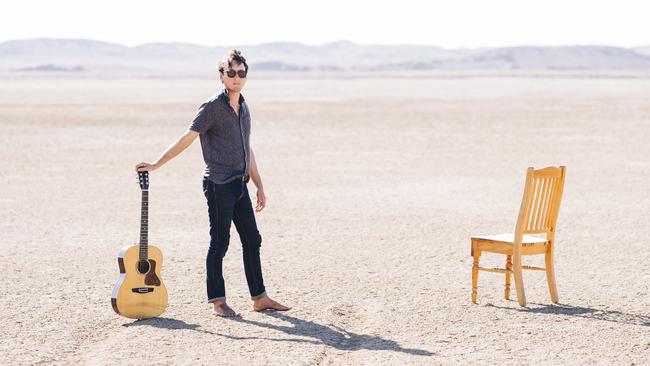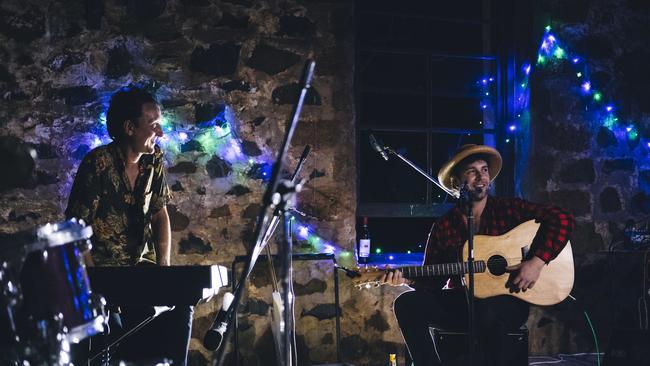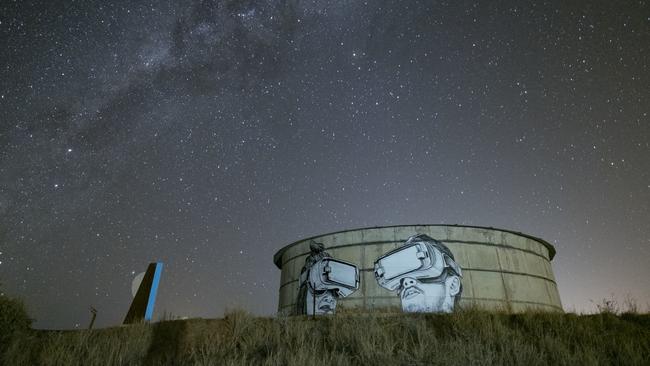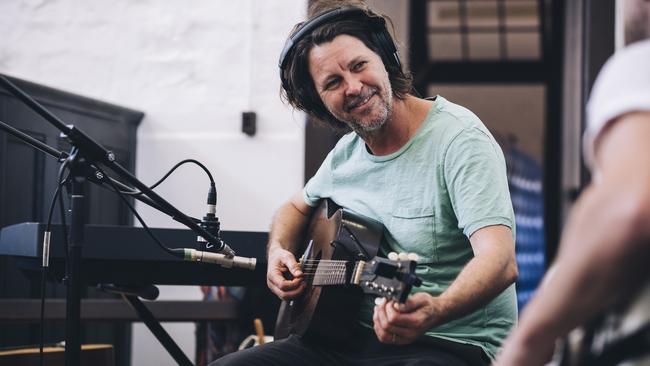Laying tracks to a ghost town
For a few nights last year, a historic outpost on WA’s Pilbara coast came to life as a hub for some of our best songwriters.

Jae Laffer was driving north from the West Australian town of Roebourne when Cossack first came into view. A hub for pearling in the 19th century, given its proximity to the northwest coast of the continent, the town had long since fallen silent after decades of disuse.
But as he set up camp with his friend, music teacher Qynn Beardman, for a night among the ghosts of pearlers past — as well as the land’s original inhabitants dating back tens of thousands of years — Laffer found himself compelled to do something he loves, but which does not always come easily: write songs.
Inspired by the isolation, the awesome terrain and the innumerable human stories that had passed through that tiny patch of coastal land, the singer and songwriter of award-winning rock band The Panics was filled with a sneaking suspicion that some of his peers might be similarly moved to create great art in this place, too.
It took a few years from that first visit to the abandoned town for the idea hatched by Laffer and Beardman to come to fruition. After making a list of great people he’d met on tour and backstage at festivals over the years, Laffer put out the call.
For four nights last September, Cossack could lay claim to the highest proportion of the nation’s great songwriters per capita, when its population swelled to about 40. Among those lured west by his siren song were Bernard Fanning (Powderfinger), Sally Seltmann (Seeker Lover Keeper), Paul Dempsey (Something For Kate), Glenn Richards (Augie March), Kav Temperley (Eskimo Joe) and Alex Gow (Oh Mercy).
They slept side by side in tents erected above gravel. They shared meals and bathrooms, and were charged with the responsibility of breathing new life into a ghost town.
“We wanted to put something on in a region where there’s been a lot of great art projects but we wanted to be the one with no agenda, no politics involved — just people working together for no reason except that they liked to create,” says Laffer. “It was basically a giant experiment, done for the right reasons.”

In pitching the concept to his peers, he was quick to emphasise their time in Cossack was more about soaking in the unique location, rather than willing themselves to produce new work. “I can’t stress enough that people were under zero pressure — and that was in writing,” says Laffer, smiling.
The Panics frontman could attest to the productivity the locale encouraged. Previous trips had already spurred the writing of two songs, which appeared on the band’s last album, 2016’s Hole in Your Pocket.
Yet the guests he invited to Cossack last September weren’t the sort of people to sit around waiting for the muse to strike, especially when most of them had travelled all the way from the east coast to breathe in the air that blows in from the Indian Ocean.
As well, an unspoken sense of healthy competition may have been floating through Cossack, as great creative minds spent their hours foraging for new musical ideas, both together and alone, while occasionally wondering what their temporary neighbours might be digging up next door.
The result of Laffer and Beardman’s ambitious idea to plant new artistic shoots in fertile soil has produced an extraordinary collection of songs connected to a particular place. Comprising 18 tracks with plenty of collaborations and cross-pollinations, the project shares its name with an adjective that frequently comes up in conversation with these artists as they reflect on their time in Cossack.
That same adjective aptly summarises the nature of the town’s surrounding Pilbara landscape, too: vast.

■ ■ ■
Paul Dempsey remembers sitting on a dirt road in Cossack, watching as the sun went down. “The sky just had this incredible clarity to it that struck me as being so clear, it’s like it’s a lack of sky,” he says.
“It wasn’t the usual blue, and there wasn’t a cloud. Even when you looked up at the stars at night, they were just so bright. You could see the whole Milky Way. It’s just so clear out there; it’s not like the sky you’re used to seeing.”
An undercurrent of anxiety runs through Dempsey’s usual songwriting process, both as the singer and guitarist of Melbourne rock band Something For Kate, and as a performer under his own name.
“I’m not a fast writer, and I’m not a very frequent collaborator,” he says. “It’s usually a very solitary exercise for me, and I agonise over things. So the idea of going somewhere, collaborating with other people and having to do something in a finite sense of time — it was just all the things to make me freak.”
Yet Dempsey’s arrangement — titled The Sky’s Gone Missing, which opens the album — arrived so fast that the songwriter still can’t quite believe it. “I wrote and finished a song from scratch in a three-day period, which is a super rare occurrence for me, ” he says. “It’s also one of the more literal songs I’ve ever written. It doesn’t have layers and layers of cryptic meaning, it’s kind of like, ‘This is what I see, this is what’s around me’.”
Recording engineer Anna Laverty set up her equipment at an old stone courthouse. “I chose the one that I thought I could control the most,” she says. “There was a couple of little rooms off that big room that I could put a vocal booth in, and some amps. It just seemed to make the most sense to me, acoustically.”
Last September, the artistic activity at Cossack was not restricted to music; visual artists and sculptors were hard at work, too, each drawing on the locale to produce works both large and small. Luthier Scott Wise was even making new instruments for the musicians to toy with, with a few of his fresh creations ending up on the recordings.
Sally Seltmann describes the creation of her song River River as “a nomadic process — usually I write a song just at a piano or in a room, and I stay there”.
In Cossack, though, she felt compelled to wander around, guitar and notebook in hand, finding different vantage points to look upon the water. “Lyrically, too, it’s just about the river being so free; it just wants to be out in the ocean which is even bigger, and more vast,” she says. “In a way, maybe I was just feeling that myself, and feeling as though I wanted to not be static, in one place.”
For Seltmann — a singer-songwriter who performs under her own name and as part of the trio Seeker Lover Keeper with Sarah Blasko and Holly Throsby — River River is a special song. “I was actually rehearsing it just the other day, and I immediately went back there in my mind to where we camped, and the landscape, and the stillness of the river at night,” she says. “It’s just really calming, and it’s nice to know I can always go there in my mind, whenever I play the song. ”
■ ■ ■
Alex Gow had gone for a morning jog down to the ocean, and lost track of time while taking in sights that his city-kid eyes had never seen before. When he got back into Cossack, he saw a text message from Laffer that the rest of the artists had headed off for a tour of some ancient rock paintings nearby.
Having missed the bus, the songwriter fortified himself with a strong coffee and went for a walk through town, feeling inspired after his private moment by the beach.
“I heard this voice that I grew up with in the distance: ‘Holy shit, that’s Bernard Fanning!’ ” recalls Gow, who fronts the Melbourne indie rock act Oh Mercy. “I didn’t think twice, I just said ‘Hi’. I had my guitar, and I said, ‘Do you mind if I play along?’” The result of that simple question is Ashes and Dust, a song the pair co-wrote on their first meeting.
“I was blown away by his generosity and faith,” says Gow of the former Powderfinger frontman. “That’s the kind of guy Bernard is, but it’s also the kind of project Vast was. If there was ever a time to write a song with this guy in his Queensland [rugby] league short-shorts from the early 90s, after his jog, it’s now. Maybe it was the shorts that he responded to; his Queensland pride kicked in.”
Fanning had another collaborative moment with Tyson Mowarin, an artist from nearby Roebourne who had also been showing the tourists around some of the indigenous landmarks that surround Cossack.
Mowarin approached him with the sketch of a song that queries why European cultural landmarks like churches are so revered in Australia, whereas places that are sacred to indigenous Australians aren’t necessarily met with the same level of respect from the wider population.

Spurred by this idea, the pair worked up a basic version of a verse and chorus with songwriter Al Pigram. “These are my cathedrals/These are my city squares,” they sang. “These are my places/Everywhere.” While Fanning was called away to sing on another recording at the courthouse, Mowarin and Pigram continued tinkering; when he returned, they showed him their new opening lines: “I am mountain/I am river/I am everything …”
Says Fanning of the finished song, named Everything: “It’s really powerfully put, the stuff that he wrote, and it really summed up what the whole project was like: I never could have written something like that, and he most likely would never have written the chorus.”
Vast was designed as a non-profit endeavour, with all proceeds from album sales to flow towards a trust. This decision was partly pragmatic, as it solved the confusion of distributing royalties among a diverse group of musicians signed to different record labels. Yet, in years to come, as the trust funds accrue, they could be used, in turn, as grants to assist artists working in remote places such as the Pilbara.
“Hopefully, we’ve showed that it is a place that’s worth staying in, and working from,” says Laffer. “Whereas, perhaps if you grew up there, you might think you were far away from the action — but, ultimately, the action is wherever is inspiring.”
■ ■ ■
Although Cossack does not quite fit the bill of tourist attraction just yet, there are plans to change that perception. In a roundabout sort of way, Vast is part of that effort, which is why the City of Karratha council invested $250,000 in Laffer and Beardman’s idea of bringing a coalition of Australian music greats to the historic ghost town, just to see what would happen.
Even if nothing of lasting value was produced, it would still be a nice story for all involved to tell, which might eventually filter back to the Pilbara, whether through tourist dollars or otherwise. Happily, Vast is much more impressive and expansive in scope than any of its participants might have dared to dream.
“It’s such a stunning result,” says Fanning. “There really wasn’t any pressure for it to be great. I could see it with Paul [Dempsey], when he was writing his song coming into the last day.
“He was just like, ‘Oh f..k, the lyrics, they’re just not good enough. I’m not finished …’ He wanted the level to be raised, and I think everyone else benefited from writing stuff that was really high quality.”
Far more than offering a simple proof of concept, the album and its accompanying short film – directed by Darren McCagh of Farmhouse Films – offer a compelling window on to a little-known part of the country.
As well, the project was created in a region whose name is more readily associated with extracting resources from the land than the inherent beauty of that same landscape.
Before Vast, perhaps the only snapshots that played on the slideshow in your mind when thinking of the Pilbara was a mass of fluoro-clad workers and a wealthy mining magnate watching over a queue of iron ore ships waiting at sea.
Now, perhaps, you’re thinking of a different story – one powered by art that lasts.
Vast is released on Friday via EMI Music.
